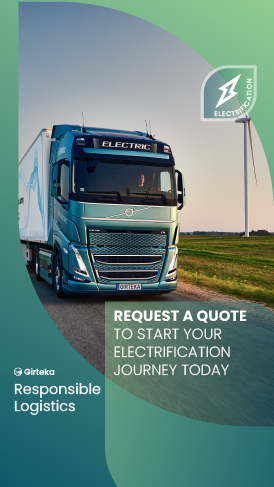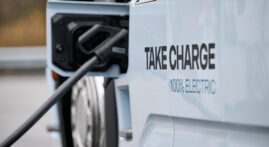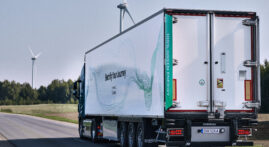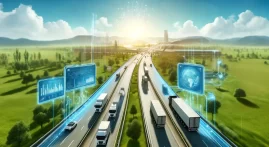Every industry that operates today is, without a question, aiming to reduce its emissions going forward and trucking is no exception to the trend, as multiple stakeholders are interested in seeing zero-emissions trucks delivering loads globally. Governments across the globe, including the European Union (EU), have passed deadlines for when their respective countries or unions they govern need to be net-zero to limit global warming below 2 degrees Celsius, a legally binding goal agreed to in Paris, France, in 2016. Thus, the direction for industries is clear. The question is, how much does the EU need to help certain sectors, including road freight transportation, to decarbonize and reach its legally binding goals?
One of the consequences of the Paris Agreement is that the EU, which submitted its National Determined Contributions (NDC) in December 2020, aims to reduce its emissions by at least 55% by 2030 from 1990 levels. According to the United Nations (UN), an NDC is defined as a national climate action plan, which enables governments to “actions they will take to reduce their greenhouse gas emissions in order to reach the goals of the Paris Agreement”. Furthermore, NDCs will lay out how these geopolitical units aim to build resilience to various consequences of a warming climate, including droughts, floods, forest fires, and so on.
As such, the EU adopted corresponding legislation to meet its own NDC by 2030 in 2018. The framework includes targets and policy objectives for the period between 2021 to 2030 and “all sectors will contribute to the achievement of the 40% target by both reducing emissions and increasing removals”, reads the bloc’s framework document.
Emissions goals for the road freight trucking industry
The basis of the question of EU’s support for the road freight industry is the fact that every sector, including the one that transports loads on Europe’s roads, will have to either eliminate or reduce its emissions drastically.
For the road freight transportation industry, the goal is to reduce its share of the total emissions in the EU. According to an overview of transportation and the European Green Deal, the European Commission (EC) outlined that “transport emissions represent around 25% of the EU’s total greenhouse gas emissions, and these emissions have increased over recent years”. Transport in this case includes private cars, aviation, trains, trucking, and shipping on various bodies of water. The European Green Deal, meanwhile, is a set of proposals to achieve the 55% emissions reduction from 1990 levels by 2030, as well as to completely decarbonize the continent by 2050.
Transport is an important economic activity within the EU because it contributes 5% to the bloc’s General Domestic Product (GDP), employs more than 10 million people in Europe and is critical to ensure that EU-based companies can participate in the global supply chain. Additionally, transportation is crucial to make sure that entities and consumers receive their desired goods for their well-being.
Nevertheless, the EU passed regulations that set emissions standards for new heavy-goods vehicles (HGV) by 2025 and 2030, as defined by Regulation (EU) 2019/1242 which entered into force on August 14, 2019. Per the law, manufacturers will be required to reduce their fleet-wide emissions by 15% from 2025, with that number growing to 30% from 2030 compared to the EU average in the reference period between July 1, 2019, and June 30, 2020. According to a summary by the EC, the first target is achievable with technologies that are available on the market right now, while the 2030 target would be reviewed at a later date.
That review came on September 7, 2022, when the EU published a briefing about reducing the emissions from HGVs in Europe. The briefing delivered a stark conclusion that “even though EU greenhouse gas emissions decreased continuously over the last decade, CO2 emissions from heavy-duty vehicles (HDV) increased every year since 2014, dropping only in 2020 because of the COVID-19 pandemic”. The improving efficiency of new trucks was not enough to offset the ever-increasing demand for road transportation.
In a separate report by the European Environmental Agency (EEA) from June 1, 2022, it determined that while current policies are set to reverse the trend of rising transportation emissions between 1990 and 2019, they are not sufficient to “reach the EU’s 2050 climate neutrality target”.
Euro 7, electric trucks, and other technologies
Whatever the case might be, truck manufacturers have had a clear target to achieve by 2025: reduce their new fleet emissions by 15% compared to the 12-month period between 2019 and 2020. The challenge, despite the bloc’s lawmakers’ conclusion that it is achievable with current means, is not an easy one.
The sector, which is highly fragmented with a lot of small to medium-sized enterprises, is in no rush to update its fleet. Despite some companies, such as Girteka having over 9,000 trucks that are on average 2 years old, trucks in the EU are on average 13.9 years old as of 2020, per the European Automobile Manufacturers’ Association (ACEA).
Another worrying trend is that “compared with 2017, in 2021 there was a decline in road freight transport performed (in tonne-kilometres) by the youngest vehicles with less than 2 years since their first registration,” read Eurostat’s overview of road freight transport by age of vehicle. “Their share of the total EU freight transport decreased from 21.6 % in 2017 to 15.8 % in 2021, a fall by 5.8 percentage points (pp)”, continued the EC’s statistical office’s overview.
The situation was not all doom and gloom, as the majority (51.1%) of the tonne-kilometres were completed by trucks that are between 2 and 5 years old, which theoretically, still adhered to the Euro 6 emissions standard that went into effect in May 2016.
On November 10, 2022, the EC presented a proposal to impose an even stricter emissions standard, namely the Euro 7. The Commission outlined that the new requirements will better control emissions of all pollutants, tighten the limits of said pollutants, regulate emissions from brakes and tires, ensure clean longevity for new vehicles, support the deployment of electric vehicles, and utilize digital possibilities for authorities to measure lifetime emissions of a vehicle by using sensors on cars.
The Euro 7 standard, if approved, is set to come into effect on July 1, 2027, for new HDVs. The EC also targeted the emissions of electric vehicles and their brakes and tires, as well as the longevity of their batteries, meaning the new emissions standard will also apply to zero-emissions vehicles.
Currently, interested parties can present their feedback to the EC until February 9, 2023, following which, the Commission will summarize and present the feedback to the European Parliament and Council.
“As the Euro 7 standards are implemented, tests and limits will be set for other types of non-exhaust emissions. For example, particle emissions from heavy-duty vehicle brakes and microplastics from tyres are expected to also be limited before the application date of the Regulation”, read the EC’s summary.
Whatever the case might be, the 2025 deadline is approaching fast, and truck manufacturers will have to act one way or another. The easiest and hardest way to reduce their fleet emissions would be to introduce zero-emissions vehicles, which, even with upcoming regulations regarding brakes, tires, and battery longevity, drastically cuts the number of pollutants of the total fleet.
It is the easiest due to the fact that zero-emissions vehicles, as their name might suggest, do not emit much in terms of CO2 or any other particles. It is the hardest due to the current technological limitations, as well as the limited infrastructure available throughout the continent, which could curb operators’ enthusiasm for ordering the pricier trucks.
Girteka recently signed a deal with Scania to order up to 600 battery-electric vehicles for delivery over the next four years. The order for the BEVs also includes a collaboration to build up charging infrastructure and optimize solutions to charge these trucks throughout Europe.
Europe’s interest in building up infrastructure
But why are road freight companies hesitant to order a larger number or perhaps even switch their whole fleets to electric trucks? Would that situation change if they were able to order hydrogen-powered HGVs?
The answer perhaps lies in a single word, namely infrastructure. In a factsheet prepared by the EC that briefly summarizes the way forward for the transport and mobility sector, there is a goal to have over 30 million passenger cars and 80,000 zero-emission trucks on the roads by 2030, combined with other means of transport that would be decarbonized, such as rail.
Overall, the goal, according to the three-page brochure from December 2020, is to reduce the number of greenhouse gases in transport by 90% by 2050. But the mini strategy paper goes a step further and indicates that the bloc should aim to “unleash the full potential of data”, as well as convert the freight transport industry to be completely paperless by 2030, coupled with a large-scale deployment of automated mobility by the same year.
Finally, to build a strong and resilient Single market, the EC sees increasing “investment in transport infrastructure across the EU Member States”, and by 2050, complete “a fully operational, multimodal, Trans-European Transport Network (TEN-T) for sustainable and smart transport with high-speed connectivity”. Would a comprehensive transport network help the road freight transport sector leave the Catch-22 situation it finds itself in, namely that without trucks there is no point in building the infrastructure, and without the infrastructure, there is no point in investing in zero-emissions transportation?
“The lack of publicly accessible charging and refuelling infrastructure dedicated to trucks is viewed as a primary roadblock to a faster transition and fleets would welcome additional support from other stakeholders to plan the build-out of infrastructure,” read an executive summary of a report, conducted by the International Council on Clean Transportation (ICCT) and European Clean Trucking Alliance (ECTA), the latter of which Girteka is part of. Other key issues were the manufacturers’ ability to produce enough trucks to scale an operator’s fleet quickly and the lack of diverse options for long-haul trucking operations, highlighted the survey released in September 2022.
Nevertheless, manufacturers have been expanding their manufacturing capabilities and at the same time, introducing new options to the market. The question of infrastructure still persists and draws a shadow over the near-term future of a zero-emissions transport sector. After all, building up infrastructure is much more complex than installing a charging station, especially for long-distance trips for HGVs, which can travel up to or even more than 1,000 kilometres to deliver a single load.
“Current battery-electric truck models have driving ranges limited to 250–300 km, creating significant operational challenges for high mileage use cases”, noted the report by the ICCT and ECTA. There can be uses for such trucks, no doubt, especially for round trips where charging infrastructure will be readily available at both ends. However, at the same time, it would limit an operator’s ability to deploy the fleet flexibly, especially considering that trucks and/or drivers have to return every few weeks due to mobility package regulations, as well as maintenance requirements. Sure, electric trucks do not require the same amount of attention as their Internal Combustion Engine (ICE) counterparts, but tires, brakes, and other wear and tear items have to be looked at continuously.
The development of TEN-T or Trans-European Transport Network could very well alleviate the problem, especially if it is coupled with building other trucking-related infrastructure for drivers as well, for example, which would also improve the working conditions of truckers throughout the continent. According to the EC’s Fit For 55 alternative fuel infrastructure regulation explanatory page, a recharging station would be found every 60 kilometres, including “one recharging station in each safe and secure parking area” for trucks, specifically. Moreover, hydrogen refuelling stations would be built every 200 kilometres, with more stations in urban areas by the end of 2030.
Solving the infrastructure problem with the development of TENT-T, which ranges from the very north of Sweden to the southernmost points in Portugal, Spain, Italy, and Greece, would significantly improve the attractiveness of zero-emissions vehicles, especially battery-powered trucks, which still lack the range to complete proper A to B distances on a single charge. After all, a typical international transportation journey was 606 kilometres, while cross-trade transport was 746.5 kilometres in 2021, according to Eurostat data.
A governmental interest
As the ICCT and ECTA study pointed out, road freight transport companies would welcome support from other stakeholders to build infrastructure. The EU is also seemingly interested in addressing the issue with its TEN-T development plans, which would result in a commitment from several interested parties to build infrastructure for zero-emissions vehicles.
The question then whether the EU needs to help the development of clean HGVs and the supporting infrastructure perhaps is rhetorical, as it would be more beneficial to ask where the bloc’s lawmakers should direct their attention to. After setting goals for manufacturers and seemingly telling them to figure out the best way to achieve the goals of reducing overall new fleet emissions by 2025, later on by 2030, and completely eliminating them by 2050, governmental figures set out to help the sector establish charging and refuelling stations for environmentally friendly trucks.
Questioning the usage of public funds to essentially enable the private sector to later utilize said infrastructure could be viable but exploring the benefits, aside from meeting the NDCs laid out against the other states signed to the Paris Agreement, could help quash those doubts about whether that is an effective usage of public funds.
While stakeholders working independently could have an immediate impact, manufacturers, trucking companies, and governments working hand in hand could hasten the bloc’s transition towards climate-neutral transportation. As the targets are clear, the technology is there, all that is needed is implementation, and that is the area where the EU’s support would be most appreciated by transport operators, namely, charging infrastructure development. Yet would that be enough to spur trucking companies to renew their entire fleets to zero-emission vehicles is another question.





